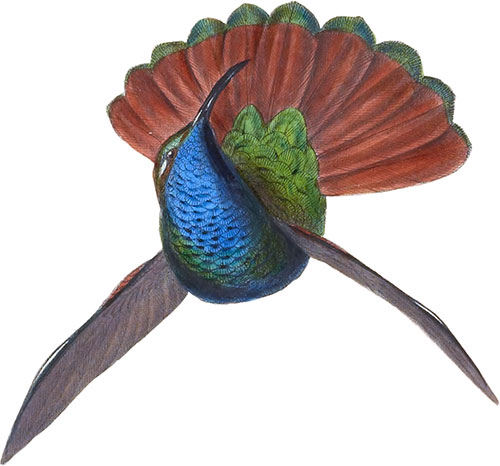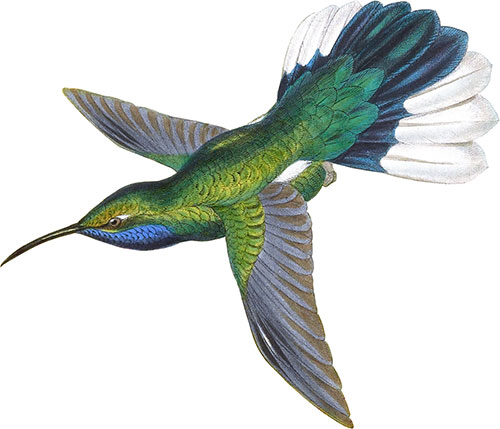Campyloterus lazulus
Habitat: Venezuela, the hilly parts of New Granada generally, and Ecuador, from which latter country I have received specimens through Professor Jameson, collected near Barza
 Plate 44
Campyloterus lazulus
Lazuline Sabre-wing
Plate 44
Campyloterus lazulus
Lazuline Sabre-wing
Campylopterus hemileucurus
Habitat: Mexico and Guatemala
 Plate 45
Campylopterus Delattrei
De Lattre’s Sabre-wing
Plate 45
Campylopterus Delattrei
De Lattre’s Sabre-wing
“The large and showy tail of this Humming-Bird,” says Mr. Salyin, “makes it one of the most conspicuous when on the wing. It is common at Coban, feeding among the Salvi; it is said also to be found in the Volcan de Fuego, but I have not met with it. The females of this species are most abundant, their ratio to the males being as five to two. It is not nearly so shy as its congener, C. rufus.” —Ibis, vol. ii. p. 260.
“This beautiful Humming-Bird,” says M. Montes de Oca, “is generally known in Mexico by the name of Chupa-mirto real azul, or Royal Blue Myrtle-sucker. It arrives in the vicinity of Jalapa, Coantepec, and Orizaba in considerable numbers during the months of October and November, and is mostly found feeding from a plant called Masapan, between the hours of nine and one o’clock. During this time it is seldom seen to alight, and then only for a very short time in any one place, but is constantly on the wing, flitting from flower to flower, describing the segment of a circle in its flight, and sometimes almost touching the ground. For the remainder of the day very few are to be seen, and I think it probable that they visit the woods for certain kinds of mosquitoes, with which I have often found their stomachs well filled.
“The pugnacity of this species is very remarkable. It is very seldom that two males meet without an aërial battle. The contest commences with a sharp choleric shriek, after which, with dilated throats, the feathers of the whole of their bodies erected on end, and their tails outspread, they begin to fight with their bills and wings, and the least powerful soon falls to the ground or flies away. I have never known one of these battles last longer than about ten seconds; and in the specimens I have had under my notice in cages, their fighting has mostly ended in the splitting of the tongue of one of the two, which then surely dies from being unable to feed.”
Campylopterus ensipennis
Habitat: The Island of Tobago
 Plate 46
Campylopterus ensipennis
Blue-throated Sabre-wing
Plate 46
Campylopterus ensipennis
Blue-throated Sabre-wing
On reference to my account of Campylopterus Villavicencio, it will be seen that I was inclined to believe the C. splendens of M. Lawrence to be identical with that bird; but on reconsidering the matter, and observing how numerous and how closely allied are the species of the genus Campylopterus, I now think it probable that it is really distinct. The throat in C. splendens is beautiful blue, and the abdomen washed with green; while in C. Villavicencio, the whole of the under-surface is pure grey. Both these birds have fine metallic-green crowns, which circumstance induced me to believe that they were opposite sexes of one and the same species, and it is possible that they may yet prove to be so; but for the present I shall regard them as distinct.
Campylopterus splendens (Lawr.)
Habitat: The forests between the upper waters of the Napo and Quito.
 Plate 47
Campylopterus splendens
Villavicencio’s Sabre-wing
Plate 47
Campylopterus splendens
Villavicencio’s Sabre-wing
Campylopterus Villavicencio
Habitat: Forests bordering the Rio Napo in Ecuador
 Plate 47
Campylopterus Villavicencio
Villavicencio’s Sabre-wing
Plate 47
Campylopterus Villavicencio
Villavicencio’s Sabre-wing
Campylopterus latipennis
Habitat: Cayenne and British Guiana
 Plate 48
Campylopterus latipennis
Broad-shafted Sabre-wing
Plate 48
Campylopterus latipennis
Broad-shafted Sabre-wing
In my account of C. latipennis I have stated my belief that another species of that particular form would be found to inhabit Ecuador, as I have in my collection a specimen received direct from Quito which does not accord with C. latipennis nor with the bird I have called C. obscurus. The tipping of the two or three outer tail-feathers of this Ecuadorian bird is about a quarter of an inch in length. Judging from the form of the shafts of the primaries, it appears to be a female or a young male; and had I not seen very many specimens of C. latipennis, I should have supposed it to belong to that species. The bill is a little longer than that of C. latipennis, and so also are the wings; as in that species, all the under-surface is pure grey, while the upper part of the body is uniform green. I believe that two specimens from the same country are in the Loddigesian collection. Provisionally, I propose for this bird the name of C. Æquatorialis.
Campylopterus Æquatorialis (Gould)
Habitat: Ecuador
No illustrations
Campylopterus obscurus (Gould)
Habitat: Forests bordering the Lower Amazon
 Plate 49
Campylopterus obscurus
Sombre Sabre-wing
Plate 49
Campylopterus obscurus
Sombre Sabre-wing
Campylopterus rufus (Less.)
Habitat: Guatemala
 Plate 50
Campylopterus rufus
Fawn-breasted Sabre-wing
Plate 50
Campylopterus rufus
Fawn-breasted Sabre-wing
Mr. Salvin noticed that, during the first season of his residence in Guatemala, this species was so scarce at Dueñas that he was induced to believe it to be an inhabitant of a higher district, especially as it was more numerous about Atitlan. The next year it was just as abundant, and, instead of being one of the rarest, was one of the most familiar species. He adds that the flowers of the Banana (Musa) were much resorted to by this bird.
Campylopterus hyperythrus (Cab.)
Habitat: The Roraima Mountains, in the interior of British Guiana
 Plate 51
Campylopterus hyperythrus
Rufous-breasted Sabre-wing
Plate 51
Campylopterus hyperythrus
Rufous-breasted Sabre-wing
Featuring all 422 illustrated species from John Gould’s A Monograph of the Trochilidæ, or Family of Humming-Birds arranged by color.